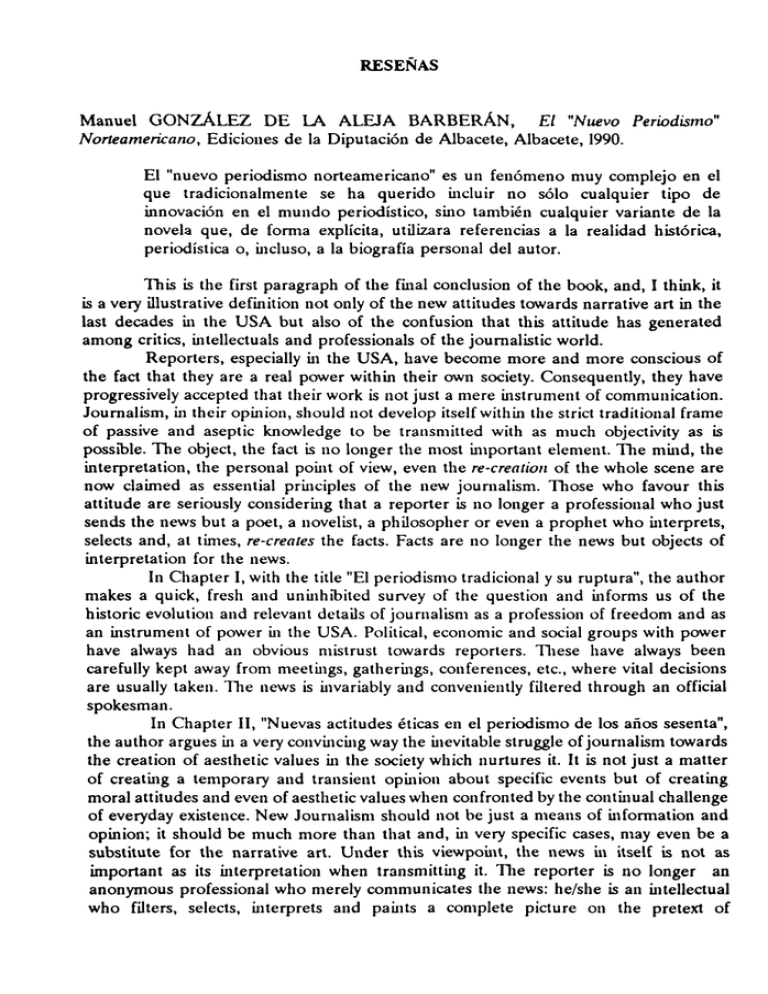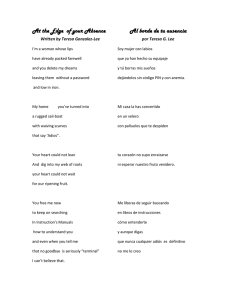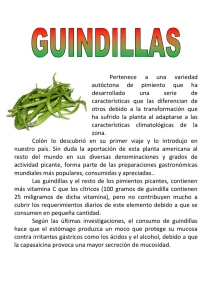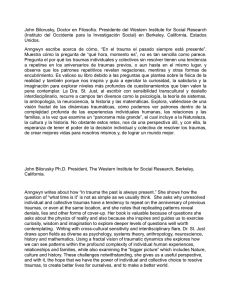Nuevo Periodismo - Universidad de Alcalá
Anuncio

RESEÑAS Manuel GONZÁLEZ DE LA ALEJA BARBERÁN, El "Nuevo Periodismo" Norteamericano, Ediciones de la Diputación de Albacete, Albacete, 1990. El "nuevo periodismo norteamericano" es un fenómeno muy complejo en el que tradicionalmente se ha querido incluir no sólo cualquier tipo de innovación en el mundo periodístico, sino también cualquier variante de la novela que, de forma explícita, utilizara referencias a la realidad histórica, periodística o, incluso, a la biografía personal del autor. This is the first paragraph of the final conclusión of the book, and, I think, it is a very illustrative definition not only of the new attitudes towards narrative art in the last decades in the USA but also of the confusión that this attitude has generated among critics, intellectuals and professionals of the joumalistic world. Reporters, especially in the USA, have become more and more conscious of the fact that they are a real power within their own society. Consequently, they have progressively accepted that their work is not just a mere instrument of communication. Joumalism, in their opinión, should not develop itself within the strict traditional frame of passive and aseptic knowledge to be transmitted with as much objectivity as is possible. The object, the fact is no longer the most important element. The mind, the interpretation, the personal point of view, even the re-creation oí the whole scene are now claimed as essential principies of the new journalism. Those who favour this attitude are seriously considering that a repórter is no longer a professional who just sends the news but a poet, a novelist, a philosopher or even a prophet who interprets, selects and, at times, re-creates the facts. Facts are no longer the news but objects of interpretation for the news. In Chapter \, with the title "El periodismo tradicional y su ruptura", the author makes a quick, fresh and uninhibited survey of the question and informs us of the historie evolution and relevant details of journalism as a profession of freedom and as an instrument of power in the USA. Political, economic and social groups with power have always had an obvious niistrust towards reporters. Tliese have always been carefully kept away from meetmgs, gatherings, conferences, etc., where vital decisions are usually taken. Tlie news is invariably and conveniently filtered through an official spokesman. In Chapter II, "Nuevas actitudes éticas en el periodismo de los años sesenta", the author argües in a very convincing way the inevitable struggle of joumalism towards the creation of aesthetic valúes in the society which nurtures it. It is not just a matter of creating a temporary and transient opinión about specific events but of creating moral attitudes and even of aesthetic valúes when confronted by the continual challenge of everyday existence. New Journalism should not be just a means of Information and opinión; it should be much more than that and, in very specific cases, may even be a substitute for the narrative art. Under this viewpoint, the news in itself is not as important as its interpretation when transmitting it. Tlie repórter is no longer an anonymous professional who merely communicates the news: he/she is an intellectual who filters, selects, interprets and paints a complete picture on the pretext of 142 Reseñas transmitting Ihe news. In this sense, he/she becomes a novelist. Indeed, many of the greatest fiction vvorks have been based upon a real experience on the part of the author. In a report, the whole truth about an event can be told but this is not the same when interpretation of that same event gets iiivolved. The novel ¡s needed for that purpose. I think that Dr. González de la Aleja sets forth Part I as an introduction to Part II in a very pedagogical way, and he goes through the different defiíiitions which joumalism has been given in the fifties and sixties in America, putting forward precise reasoning and clear evidence which have been coutrasted with the actual texts. With great discemment, he gradually familiarizes the reader with such expressions as "participant joumalism," "advocacy joumalism," "modern muckraking" and "investigative joumalism;" occasionally reminding us of how subjectivism has gradually penetrated and infected the most respectful valúes of traditional joumalism. Impressionistic techniques may even fomi part of the methodology of joumalism—this may seem too heterodox: impressionistic joumal¡sm!1!--but Dr. González de la Aleja argües this point in a very convincing way and shows its feasibility beyond doubt. Part II, entitled "The New Joumalism" is really the solid substance of the book. In Chapters III and IV, the author tries to give a definition and to enumérate the technical recourses of the new joumalism. The general approach to the definition itself proves to be interesting. It makes you think again about the obvious parallels between Brítish fiction in the early 20th Century and certain concepts of the new American joumalism. Tlae same necessary confrontation between ethics and aesthetics which reminds us of J. Joyce and V. Woolf. I would like to point out two of the most significant technical expressions which the author underlines as the basic recourses of the new joumalism, that is to say, Composite Characterization and Metajoumalism. Tlie former to define the peculiar mixture of fiction and fact""fiction in that none of the characters or events is an impossíbility in the junkie world" (107-108); the latter to describe the inner conviction of the repórter that, when he/she faces certain raw-materials, he/she feels compelled to communicate to the reader not only the facts but how he himself7she herself got to the facts and interpreted them. Consequently, we go back to our first concem about joumalism becoming corrupted with impressionistic devices. Further on, in Chapter V, we discover that the same vital question that has raised in fiction is now raised in joumalism: the point of view. It is interesting to note that, depending on the point of view of the reporters, there are already clichés which attempt to describe the different techniques: subjective joumalism, personalized joumalism, personal joumalism and existential joumalism. Tliis also changes the position of the author and he has to adopt a different attitude; either as a puré professional with no emotional approach, as a mere observer or as a human being absorbed and totally identified with the subject matter of his research. Finally, we come to an excellent reflection on the point of view of the characters of the stories themselves and on the perplexing question of the omniscient repórter. At this point, the confusión is such that apparently one can talk of an "omniscient jouraalirm". What utter Reseñas 143 nonsense! Is it possible to thiiik of this expression without beüig conscious of the inner contradiction of the two terms? Is the repórter supposed to know about the news before it takes place or has he/she reduced news (extemal facts) to the field of his mental frame? Dr. González de la Aleja makes here a very vivid description of the problem and shows a solid argumentation and mature points of view in favour and against. In Chapter VI, the author offers us an iuteresting comment about Tom Wolfe's feelings towards the idea of "new joumalism". Together with N. Mailer, T. Capote, G. Tálese, etc., T. Wolfe represents one of the most interesting figures who has helped to define the new attitudes in the American joumalistic worid; some of them, as we have previously pointed out, have gradually become more and more confusing. Dr. González de la Aleja attempts to clarify certain concepts among this confusión and manages to throw some light on the problem with this excellent research work. Many a time we have heard of the death of fiction. The new joumalism can be a double-edged sword. On the one hand, it could bring about a new impulse and a regeneration of the fiction world; on the other, it could mean its definite death trap. It worries me that somebody can talk of an "omniscient joumalist" and this can be taken seriously. It might be more exact to talk about a fabulist joumalist. When talking about this, there are immediately various questions which arise: Is there a clear line between reality and fictitiousness? Is documentary realism possible? I think the book we are reviewing comes out at a very appropriate time and helps to enlighten some of the dark points of the question a great deal. In America, the discussion has been going on for years, in Spain it is still quite fresh. Tliis research study comes just in time as a warning note for those who are interested in the problem and I think it contributes with serious weighty arguments to the clarification of the question. Antonio R. Celada Universidad de Salamanca 144 Reseñas José BARÓN FERNÁNDEZ, La Guerra Hispano-norieamericana de 1898, Ediciones Dos Castas historia, La Coruña, 1993. La bibliografía existente sobre la guerra de Cuba y Filipinas es extensísima pero esta abundancia no ha hecho decrecer en interés y siguen apareciendo libros: monografías, tratados, biografías... que con cierta perversidad -para los estudiosos y los curiosos del tema- y con indudable perseverancia tratan "El 98". Buena prueba de ello es este trabajo reciente que, en relativamente pocas páginas, ofrece un detallado cuadro de los acontecimientos que culminaron con la firma del Tratado de París entre España y EEUU el 10 de Diciembre de 1898, por el cual perdíamos Cuba, Puerto Rico, Filipinas, las islas de la Indias Occidentales y la isla de Guam en el Archipiélago de las Marianas. Por la reseña biográfica que aparece en la contraportada sabemos que su autor, Barón Fernández, es médico de larga y fecunda experiencia profesional y autor de varios libros de medicina. Con este título nos presenta otra faceta suya, ya bien probada en otros volúmenes, la de historiador de prolija y rigurosa documentación, curioso de bibliotecas y archivos y lector infatigable. Entronca por lo tanto Barón Fernández con ese escogido grupo de hombres de la medicina, cuyo máximo representante es el doctor Marañón, de inquietud humanista que les lleva a explorar otros horizontes alejados de su profesión. El texto se lee con facilidad e interés, en parte debido a la organización rigurosamente cronológica y porque las disgresiones del tema principal son escasas. Al no ser una monografía intenta tocar todos los aspectos del conflicto, así por ejemplo dedica dos capítulos, uno por Cuba y otro por Filipinas, a la historia de las insurrecciones en ambas colonias antes de la guerra del 98, desde "El Grito de Yara" en 1868 en Cuba y el "motín de Cavite" en 1872 en Filipinas, pero la obra se centra sobre todo en las operaciones militares- la guerra propiamente dicha- entre EEUU y España. Como historia que es de una guerra, todos los aspectos militares (movimiento de tropas, posiciones militares, armamento y munición) están descritos con gran detalle y documentados con gran rigor pero siempre en función de las causas que los originaron (políticas y sociales) y las consecuencias y responsabilidades, estas últimas recaen sobre todo en la miopía de los políticos españoles, su arrogancia, y la inferioridad de nuestra escuadra. No es una historia militar, ni una historia social, ni una historia económica, es sobre todo el relato de una tragedia cuya expresión dramática aparece en los enfrentamientos entre el Almirante Cervera y el Gobernador Blanco Esenas y la quejas del primero en cartas y telegramas al Ministro de la Guerra (municiones deterioradas, naves averiadas, equipos mal pertrechados, escasez de combustible) que recuerdan la Guerra de Gila. Desfilan a lo largo de la obra desde los libertadores como Rizal o Martí, los políticos y militares estadounidenses, algunos de ellos cómicos -véase el "mensaje a García", y los correspondientes españoles con las tensiones políticas que sufrió España en esos años y los esfuerzos, desoídos por la parte americana, de la Reina Regente por hallar una solución pacífica que no dejase las colonias en manos americanas. Reseñas 145 La bililiografía comprende 187 títulos, entre ellos artículos de revistas y gran número de manuscritos de diferentes archivos tanto españoles como americanos. De libros publicados, 36 lo fueron en la década de los 70 (el 20% de la totalidad de los textos consultados) y un número similar, 33, a los años del conflicto 1897-98 y los inmediatamente posteriores. Algunas obras son de carácter general como La historia de España de Raymond Carr (Oxford 1966) o de referencia literaria y social como El espectador de Ortega. Hay bastantes colecciones de documentos como Relación documentada de mi política en Cuba de Polavieja (Madrid, 1898 con afanes exculpatorios y monografías y tratados españoles y americanos, pero se echa en falta un índice onomástico y algún mapa para evitar el trabajo de acudir a los atlas. Sol Pruneda Universidad de Alcalá






